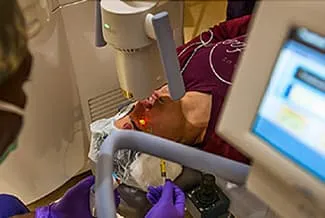Corneal cross-linking is a treatment for an eye problem called keratoconus.
In this condition, the front part of your eye, called the cornea, thins out and gets weaker over time. This makes it bulge into a cone shape, which can distort your vision and make it hard to see. If the symptoms of keratoconus get severe, you will need a corneal transplant.
In corneal cross-linking, doctors use eyedrop medication and ultraviolet (UV) light from a special machine to make the tissues in your cornea stronger. The goal is to keep the cornea from bulging more.
It’s called “cross-linking” because it adds bonds between the collagen fibers in your eye. They work like support beams to help the cornea stay stable.
Corneal cross-linking is the only treatment that can stop progressive keratoconus from getting worse. And it may help you avoid a corneal transplant, which is major surgery.
What Happens During the Procedure

Your doctor can do the corneal cross-linking procedure in their office.
First, you’ll get drops that numb your eyes and a medicine to calm you if needed.
Then, your doctor will put in specially formulated riboflavin (vitamin B2) eyedrops, which allow your cornea to better absorb light. It takes about 30 minutes for the drops to soak into your cornea.
Then, you’ll lie back in a chair and look up at a light. You shouldn’t feel any pain during the procedure because your eyes will be numb.
The entire treatment takes about 60-90 minutes.
Types of Corneal Cross-Linking
There are two types: epi-off and the experimental epi-on. (“Epi” is short for epithelium, the outer layer of the cornea.)
The epi-off technique means your doctor removes the epithelium before they put the drops in.
With epi-on, your doctor loosens your epithelium with eyedrops or a sponge before they put the eyedrops in.
Who Should Get Corneal Cross-Linking?
The procedure doesn’t reverse cornea changes that have already happened -- it just keeps them from getting worse. Since it can help slow progression, it’s best to talk to your doctor sooner than later if you have keratoconus.
Your doctor can let you know if this treatment would help you.
How to Prepare
The day of the procedure, don’t wear eye makeup, perfume, or after-shave. In most cases, you’ll be able to eat a light meal and drink fluids beforehand.
You’ll also need someone to drive you home after your procedure since your eyesight will be affected.
Follow your doctor’s instructions carefully.
What Happens Afterward?
After the procedure, here’s what you need to know to take care of your eyes:
- You may have discomfort for a few days. Your doctor will give you medication for discomfort if needed.
- Your doctor will put a contact lens in your eye to help it heal. If it falls out, let your doctor know. Do not try to put it back in.
- It’s important to not rub your eyes for 5 days after the procedure.
- You may have sensitivity to light. Sunglasses can help. Some people feel like they have something in their eye at first.
- If you have severe pain or a sudden worsening of your eyesight, let your doctor know right away.
Your Vision After Corneal Cross-Linking
After a cross-linking procedure, your eyesight will be blurry at first. You may notice changes in your vision from time to time to time during the healing process. You may be more sensitive to light and have poorer vision for about 1-3 months after the surgery.
The goal of corneal cross-linking is to slow your disease and prevent future vision problems, but in some cases, your eyesight may get better over time.
Once you’ve had corneal cross-linking, you might need new glasses or contacts.
Risks
Like most surgeries, corneal cross-linking can sometimes cause problems, such as:
- An eye infection
- Eye pain or swelling
- Damage to the cornea or epithelium
- Blurred vision, hazy vision, or other vision problems
Before you have the procedure, ask your doctor about your chances of having these issues.

